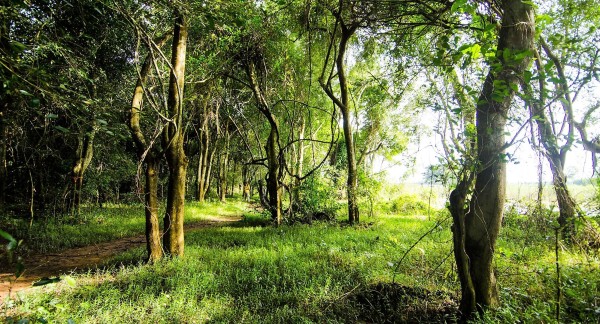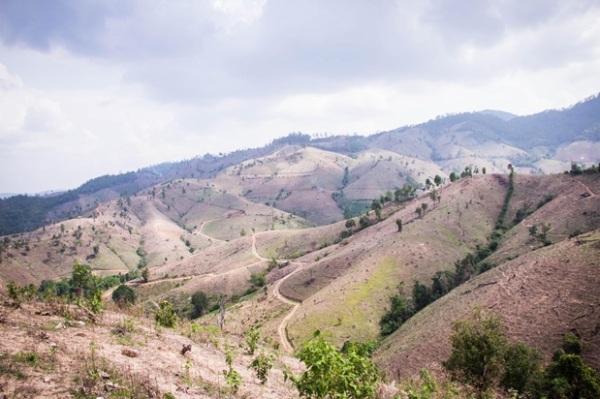Jonas Dahlstrom & Binod Chapagain, RECOFTC
Taking a landscape approach in implementing activities is central to RECOFTC’s upcoming strategic plan. A landscape approach focuses on stakeholders at a scale that is small enough to maintain a degree of manageability, whilst simultaneously operating in a context large enough to be able to deliver multiple outcomes to stakeholders with different interests. The approach emphasises the interdependence of natural resources, people and communities. All natural resources impact each other and their use is interconnected with existing social and economic systems.
The logic of landscape programming is that program staff and partners should always consider the impact of their activities on the broader landscape. For instance, a project aimed at improving social benefits through growing a particular plant in a community should consider the ways in which this activity might impact the wider social, financial and ecological systems (no matter what the actual goal of the activity might be). As no system stands alone in a globalized world, RECOFTC believes that taking a landscape approach is the way to proceed to ensure lasting improvements in human well being and healthy forests.
In fact, RECOTFC’s approach aims to build lasting relationships with all stakeholders and achieve a common vision for what that landscape should look like and provide in terms of services and products.

The Ing River
This blog reflects the lessons from conversations with several stakeholders, including local communities, civil society organizations, fishery department, royal forest department, and the chamber of commerce in the Ing Watershed in Northern Thailand earlier this year.
Our first lesson from the trip was that the objectives of all stakeholders have to be considered to accurately understand social and environmental impacts in a landscape. From an academic angle, it is important to understand the ambitions of all actors when measuring a landscape’s (or community’s) ability to adapt to climate change. Without knowing all players’ intentions it is difficult to make future predictions about environmental or social impacts. Furthermore, from a social angle communities will be best off when local and external stakeholders collaborate for mutual benefits, such as income generation and sustainable resource management.
The second lesson, as shared by community representatives, was about the younger generations’ contributions to bring changes in forest management with the help of technology, specifically through social media. The youth in one community have contributed to an improved online system to store, manage and benefit from data for various natural resources. They also developed connections with young people who migrated from their villages to towns and cities to gain their support in information management. The youth in the community were able to build a new informal network and connect with other communities and forest department officials. These new avenues of information sharing have led to new opportunities for local people to understand the diverse resources in their landscape, as well as increasing youth involvement and leadership in sustainable natural resource management processes.
The third lesson was that improved management of landscape resources by local communities contributes to reforestation, rehabilitation of original species, and ecological restoration. Reforestation and the protection of wetlands has helped local people to deal with climate change impacts, such as preventing flash floods, which used to occur when their resources were depleted.

Ban Boonreung wetlands in the Ing Watershed
It was also clear that local people alone cannot manage the landscape where multiple actors have interests. Effective and sustainable landscape management requires mobilization of the migrant population; collaboration with multiple actors; use of information technology to share and learn; and importantly, long-term sustainable landscape planning with funding commitments from government, private sector and funding agencies. The need to consider multiple actors interests is also important if we are to avoid the more destructive elements that economic policies can have on environmental and social issues.
In managing ecosystems local people hold the key to effective landscape management and healthy landscape resources (e.g., water, forests and land). Their participation is crucial to build long-term solutions and prevent potential conflicts over resources. In fact, environmental and social issues cannot be addressed without the informed participation of multiple actors, including local women, men and youths and their access to relevant information. In the Ing Watershed, youth demonstrated their ability to organize and disseminate information, which was a catalyst to establishing connections between local communities, broader civil society and government. The Ing Watershed experience shows that informed participation has ultimately benefited the landscape, resources, environment and people living in the area.

RECOFTC staff together with local community in Ban Boonreung
Read more on RECOFTC in the Ing Watershed:
https://www.recoftc.org/press-releases/civil-society-groups-gather-ing-watershed-forum-world-water-day
For Thai speakers
More on RECOFTC’s work in the Ing River can be found here: https://www.recoftc.org/project/%E0%B9%82%E0%B8%84%E0%B8%A3%E0%B8%87%E0%B8%81%E0%B8%B2%E0%B8%A3%E0%B8%AD%E0%B8%99%E0%B8%B8%E0%B8%A3%E0%B8%B1%E0%B8%81%E0%B8%A9%E0%B9%8C%E0%B8%A5%E0%B8%B8%E0%B9%88%E0%B8%A1%E0%B8%99%E0%B9%89%E0%B8%B3%E0%B8%AD%E0%B8%B4%E0%B8%87
A video on the Ing River can be found here: https://www.youtube.com/watch?v=Oj9L0AZPwxs















Knowledge is power: protecting forests with carbon assessments and open data
Kerry Woodward – RECOFTC
Carbon assessments in Northern Thailand have proved instrumental to communities advocating for the protection of their forests. Communities in Chiang Khong district have been under pressure to capitulate to the incursions of a planned Special Economic Zone that would cover their community forest.
While the forest was full of resources and culturally significant to people living in and around it, the community struggled to articulate the value of their forest in terms that would be understood to outsiders. “[Communities could] only see the traditional value of the forest in terms of the medicinal plants or wood that can be used, we can now highlight the value to people outside of the community”, says Sayan Khanmueng from Living River Association (LRA).
Policy implementers should have a complete picture of the value of natural resources and landscapes to local people if they want to implement policy that offers beneficial outcomes for all the stakeholders in forested landscapes.
As outsiders, it may be difficult for external agencies to appreciate the diversity of economic and cultural benefits that communities derive from forests. This is certainly understandable and warrants a new approach to community engagement on forests and the benefits they offer.
Forest ecosystems provide services for people on both local and global scales. The most commonly recognized ecosystem service is the role that forests play in carbon sequestration, with REDD+ (Reducing Emissions from Deforestation and Degradation) as an international mechanism designed by the international community intended to maintain and enhance this service.
New tools such as Global Forest Watch and SERVIR-Mekong’s EcoDash, allow for greater appreciation of forests and biomass. While these open source tools provide global and regional insights into forest resources and services, they do not always lead to local empowerment.
RECOFTC has been working with communities in Chiang Khong District in an effort to help communities highlight the value of forests to policy makers and external agencies, and to empower communities with scientific knowledge of their forests. The aim of this capacity development is not to undermine national level carbon accounting or monitoring, but rather to empower local communities to understand carbon within the context of broader natural resource management (NRM).
So far RECOFTC has trained eight villages on measuring the carbon content of their trees. The method involved measuring the circumference of trees and then inputting the data into software which calculated the carbon content of their forests.
The information was used in three ways. Firstly, it was used for internal awareness raising about the potential value of the communities’ forests beyond the immediate livelihood products – wood, mushrooms, fruit. The forests have value in terms of carbon sequestration, and potentially offer economic value in carbon credits. Secondly, the information has been fed into the communities’ natural resource management plans. Finally, the information was used to negotiate with local authorities to protect the forest from becoming a Special Economic Zone (SEZ).
Sayan Khanmueng confirms that “the data has been used for public awareness, we can show how much carbon is stored, and we can show the value of trees in terms of how much oxygen they produce.”
The experience in the Ing Watershed highlights the power of knowledge and the open data movement. The community now understands the importance of forest mapping, inventories and scientific knowledge in advocating for forest protection and for the maintenance of community livelihoods. Moreover, the information they have collected in the process has already had beneficial impacts for the community in serving as a negotiation tool and in informing natural resource management plans.
Share this:
Posted by RECOFTC on December 4, 2017
https://recoftc.wordpress.com/2017/12/04/knowledge-is-power-protecting-forests-with-carbon-assessments-and-open-data/